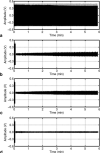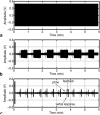Extraction of overt verbal response from the acoustic noise in a functional magnetic resonance imaging scan by use of segmented active noise cancellation
- PMID: 15723385
- PMCID: PMC3591487
- DOI: 10.1002/mrm.20398
Extraction of overt verbal response from the acoustic noise in a functional magnetic resonance imaging scan by use of segmented active noise cancellation
Abstract
A method to extract the subject's overt verbal response from the obscuring acoustic noise in an fMRI scan is developed by applying active noise cancellation with a conventional MRI microphone. Since the EPI scanning and its accompanying acoustic noise in fMRI are repetitive, the acoustic noise in one time segment was used as a reference noise in suppressing the acoustic noise in subsequent segments. However, the acoustic noise from the scanner was affected by the subject's movements, so the reference noise was adaptively adjusted as the scanner's acoustic properties varied in time. This method was successfully applied to a cognitive fMRI experiment with overt verbal responses.
(c) 2005 Wiley-Liss, Inc.
Figures






Similar articles
-
Acoustic FMRI noise: linear time-invariant system model.IEEE Trans Biomed Eng. 2008 Sep;55(9):2115-23. doi: 10.1109/TBME.2008.923112. IEEE Trans Biomed Eng. 2008. PMID: 18713680
-
Real-time noise cancellation for speech acquired in interactive functional magnetic resonance imaging studies.J Magn Reson Imaging. 2010 Sep;32(3):705-13. doi: 10.1002/jmri.22285. J Magn Reson Imaging. 2010. PMID: 20815071 Review.
-
An efficient feedback active noise control algorithm based on reduced-order linear predictive modeling of FMRI acoustic noise.IEEE Trans Biomed Eng. 2011 Dec;58(12):3303-9. doi: 10.1109/TBME.2010.2096423. Epub 2010 Dec 3. IEEE Trans Biomed Eng. 2011. PMID: 21134809
-
Towards undistorted and noise-free speech in an MRI scanner: correlation subtraction followed by spectral noise gating.J Acoust Soc Am. 2014 Mar;135(3):1019-22. doi: 10.1121/1.4864482. J Acoust Soc Am. 2014. PMID: 24606243
-
Acoustic noise concerns in functional magnetic resonance imaging.Hum Brain Mapp. 2003 Nov;20(3):123-41. doi: 10.1002/hbm.10134. Hum Brain Mapp. 2003. PMID: 14601139 Free PMC article. Review.
Cited by
-
Neural correlates of word production stages delineated by parametric modulation of psycholinguistic variables.Hum Brain Mapp. 2009 Nov;30(11):3596-608. doi: 10.1002/hbm.20782. Hum Brain Mapp. 2009. PMID: 19365800 Free PMC article.
-
Functional activation in the cerebellum during working memory and simple speech tasks.Cortex. 2010 Jul-Aug;46(7):896-906. doi: 10.1016/j.cortex.2009.09.009. Epub 2009 Sep 23. Cortex. 2010. PMID: 19853247 Free PMC article.
-
Adaptive speech enhancement using directional microphone in a 4-T MRI scanner.MAGMA. 2015 Oct;28(5):473-84. doi: 10.1007/s10334-015-0485-4. Epub 2015 Apr 18. MAGMA. 2015. PMID: 25894814
References
-
- Schmitt F, Stehling MK, Turner R. Echo-planar imaging theory, technique, and application. Springer; New York: 1998.
-
- Cho ZH, Park SH, Kim JH, Chung SC, Chung ST, Chung JY, Moon CW, Yi JH, Sin CH, Wong EK. Analysis of acoustic noise in MRI. Magn Reson Imaging. 1997;15:815–822. - PubMed
-
- Phelps EA, Hyder F, Blamire AM, Shulman RG. FMRI of the prefrontal cortex during overt verbal fluency. Neuroreport. 1997;8:561–565. - PubMed
-
- Schlaggar BL, Brown TT, Lugar HM, Visscher KM, Miezin FM, Petersen SE. Functional neuroanatomical differences between adults and school-age children in the processing of single words. Science. 2002;296:1476–1479. - PubMed
-
- Anderson JR, Qin Y, Stenger VA, Carter CS. The relationship of three cortical regions to an information-processing model. Cogn Neurosci. 2004;16:637–653. - PubMed
MeSH terms
Grants and funding
LinkOut - more resources
Full Text Sources
Medical

